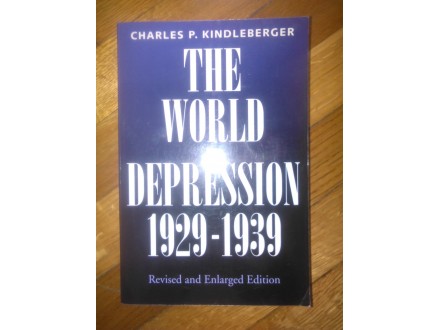Svet u depresiji 1929-1939- Kindlberger -
| Cena: |
| Želi ovaj predmet: | 4 |
| Stanje: | Polovan bez oštećenja |
| Garancija: | Ne |
| Isporuka: | Pošta CC paket (Pošta) Post Express Lično preuzimanje |
| Plaćanje: | Tekući račun (pre slanja) Lično |
| Grad: |
Beograd-Vračar, Beograd-Vračar |
ISBN: Ostalo
Godina izdanja: 1986.
Jezik: Engleski
Autor: Strani
Charles P. Kindelberger - The World in Depression 1929-1939
Revised and Enlarged Edition
California University Press, 1986.
Mek povez, 355 strana.
U svom čuvenom delu o Velikoj depresiji ekonomista Čalrs Kindlberger naglašava tri faktora koja neprekidno oblikuju globalna finansijska tržišta: paniku, moć zaraze i važnost hegemonije. Ponovo objavljeno na četrdesetogodišnjicu od prvog izdanja, uz novi predgovor koji su napisali Bari Ajkengrin i Dž. Bradford Delong, ovo remek-delo ekonomske istorije otkriće nam zbog čega se ministar finansija SAD Lorens Samers u najmračnijim trenucima globalne finansijske krize 2008. obratio za pomoć Kindlbergeru i njegovim kolegama.
„Kindlberger je napisao možda najfiniji analitički prikaz zahuktavanja Velike depresije i ispratio delimično oporavljanje od krize i približavanje Drugog svetskog rata. Ovo je opomena vodećim glavama svetske ekonomije da razmisle o svakoj pojedinosti onoga što trenutno nameravaju da urade.“
– Times Literary Supplement
„Kindlberger nas vodi kroz desetogodišnju depresiju godinu po godinu i analizira investicije, trgovinu, tržište novca i hartija od vrednosti, te kretanje vrednosti zlata u Sjedinjenim Američkim Državama i Zapadnoj Evropi. Knjiga je puna oštroumnih uvida u vezi sa motivacijom glavnih aktera, koji se zasnivaju na autorovom sećanju, ali i radu istoričara ekonomije. U knjizi ne postoji ni jedna jedina jednačina, a grafikoni i tabele su dovoljno razumljivi i za one među nama koji mrze brojeve.“
– American Historical Review
„Ne znam ni za jednu knjigu o Velikoj depresiji pre ove u kojoj se akcenat stavlja upravo na sagledavanje krize u čitavom svetu, što je karakteristično za savremene trgovačke i makroekonomske teorije.“
– Journal of Economic Literature
Charles Poor Kindleberger (October 12, 1910 – July 7, 2003) was an American economic historian and author of over 30 books. His 1978 book Manias, Panics, and Crashes, about speculative stock market bubbles, was reprinted in 2000 after the dot-com bubble. He is well known for his role in developing what would become hegemonic stability theory,[1][2] arguing that a hegemonic power was needed to maintain a stable international monetary system.[3] He has been referred to as `the master of the genre` on financial crisis by The Economist.[4]
Life
Background
Kindleberger was born in New York City on October 12, 1910. He graduated from the Kent School in 1928, the University of Pennsylvania in 1932, and received a PhD from Columbia University in 1937.[5]
During the summer of 1931, he traveled to Europe and attended a seminar hosted by Salvador de Madariaga, but, when the latter was appointed Spanish Ambassador to the United States, Kindleberger attended lectures at the Graduate Institute of International Studies in Geneva led by Sir Alfred Zimmern.[6]
Government
Treasury
While writing his thesis, Kindleberger was employed temporarily in the international division of United States Treasury under the direction of Harry Dexter White. He then joined the Federal Reserve Bank of New York full-time (1936–1939). Subsequently, he worked at the Bank for International Settlements in Switzerland (1939-1940), the Board of Governors of the Federal Reserve System (1940–1942). During World War II, he served in the Office of Strategic Services (OSS). From 1945 to 1947 he was Chief of the Division of Economic Affairs of Germany and Austria at the United States Department of State.[7]
Marshall Plan
Kindleberger was a leading architect of the Marshall Plan. In 1945–1947 he served at the Department of State as Acting Director of the Office of Economic Security Policy, and briefly from 1947-48 as counselor for the European Recovery Program.[7]
He described his around-the-clock work to develop and launch the Marshall Plan with singular passion in a 1973 interview:
We were conscious of a great sense of excitement about the plan. Marshall himself was a great, great man—funny, odd but great—Olympian in his moral quality. We`d stay up all night, night after night. The first work ever done that I know about in economics on computers used the Pentagon`s computers at night for the Marshall Plan. I had a tremendous sense of gratification from working so hard on it.[8]
Harry Dexter White
Though he himself was spared anti-communist investigation during the 1950s, he later recalled:
...I worked in the Treasury under Harry Dexter White. That gave me a lot of trouble later on because he got in trouble, and anybody who was infected by him got into trouble, too. The FBI listened to my phone calls and things I said in the course of my work at the State Department and gave gossip and some misrepresentations to columnists like George Sokolsky. J. Edgar Hoover fed them such gossip.[9]
Academia
After 1948, Kindleberger was appointed Professor of International Economics at MIT.[5] He retired from a full-time position in 1976 and continued as a senior lecturer until full retirement from teaching in 1981.[8]
He partook in working groups of the Council on Foreign Relations.[7] He later held the position of Ford International Professor of Economics at the Massachusetts Institute of Technology.
Honors
1944 Bronze Star
1945 Legion of Merit
1954 elected member of the American Academy of Arts and Sciences[10]
1966 Dr. h.c., University of Paris
1977 Dr. h.c., University of Ghent
1978 Harms Prize, Institut für Weltwirtschaft, Kiel
1984 Dr. Sci. h.c., University of Pennsylvania
1987 elected member of the American Philosophical Society[11]
1989 Bicentennial Medal, Georgetown University[12]
Personal
Kindleberger was married to Sarah Miles Kindleberger for 59 years. They had four children: Charles P. Kindleberger III,[13] Richard S. Kindleberger (a reporter for the Boston Globe), Sarah Kindleberger, and E. Randall Kindleberger.[7][14]
He died of a stroke on July 7, 2003, in Cambridge, Massachusetts.[7]
Work
Kindleberger wrote 30 books: International Short-Term Capital Movements in 1937, and the others beginning in 1950.
As an economic historian, Kindleberger used a narrative approach to knowledge, not based on mathematical models. In the preface to The Great Depression 1929-1939, he wrote: `It`s the story simply told, without tables of squares...`[7]
His book Manias, Panics, and Crashes is still widely used in Master of Business Administration (MBA) programs in the United States.
Hegemonic stability theory
Main article: Hegemonic stability theory
In his 1973 and 1986 book The World in Depression 1929–1939, Kindleberger advances an idiosyncratic, internationalist view of the causes and nature of the Great Depression, which concludes that a world hegemon is necessary for a generally stable world economy.[15] Blaming the peculiar length and depth of the Depression on the hesitancy of the US in taking over leadership of the world economy when Britain was no longer up to the role after World War I, he concludes that `for the world economy to be stabilized, there has to be a stabilizer—one stabilizer`, by which, in the context of the interwar years at least, he means the United States. In the last chapter, `An Explanation of the 1929 Depression`, Kindleberger lists the five responsibilities the US would have had to assume in order to stabilize the world economy:
maintaining a relatively open market for distress goods;
providing countercyclical, or at least stable, long-term, lending;
policing the relative stability of exchange rates;
ensuring the coordination of nations` macroeconomic policies;
acting as a lender of last resort by discounting, or otherwise providing liquidity, in a financial crisis.
Kindleberger was highly skeptical of Milton Friedman and Anna Schwartz`s monetarist view of the causes of the Depression, seeing it as too narrow and perhaps dogmatic, and dismisses out of hand what he characterized as Paul Samuelson`s `accidental` or `fortuitous` interpretation. The World in Depression was praised by John Kenneth Galbraith as `the best book on the subject`.[citation needed]
For Kindleberger, the main problem with international institutions is that they provide public goods whose provision states are incentivized to free-ride on.[16] Following Mancur Olson, Kindleberger argued that the solution to the free-riding problem was to have an actor who was large enough (a hegemon) and willing to bear the cost of cooperation alone.[16]
Books
International Short-term Capital Movements (NY: Columbia University Press, 1937)
International Economics (Irwin, 1953)
Economic Development (New York, 1958)
Foreign Trade and the National Economy (Yale, 1962)
Europa and the Dollar (Cambridge, Massachusetts, London, 1966)
Europe`s Postwar Growth. The Role of Labor Supply (Cambridge, Massachusetts, 1967)
American Business Abroad (New Haven, London, 1969)
The Benefits of International Money. Journal of International Economics 2 (Nov. 1972): 425–442.
The World in Depression: 1929–1939 (University of California Press, 1973);[17] Kindleberger, Charles P. (1986). revised and enlarged edition. University of California Press. ISBN 9780520055926.
Manias, Panics, and Crashes: A History of Financial Crises (Macmillan, 1978)
Historical Economics – Art or Science? (1990) (online book)[18][19]
A Financial History of Western Europe (New York, 1984)
World Economic Primacy: 1500 – 1990 (Oxford University Press, 1996)
Centralization versus Pluralism (Copenhagen Business School Press, 1996)
Economic Laws and Economic History (Cambridge University Press, 1997)
Predmet: 76978365







